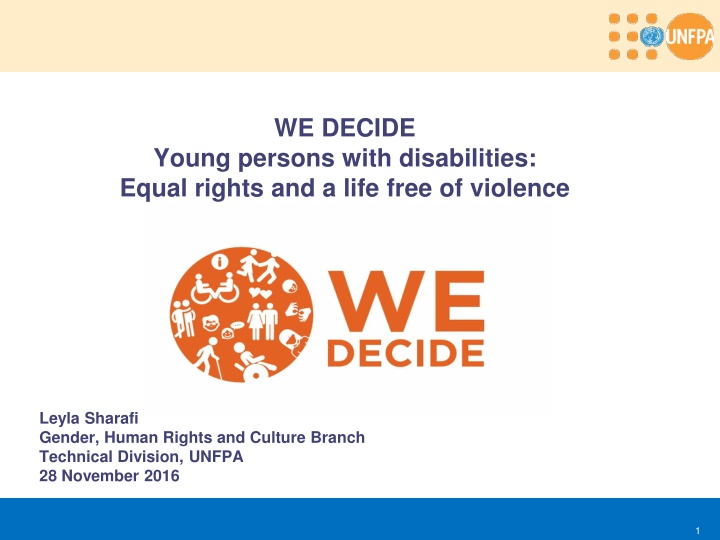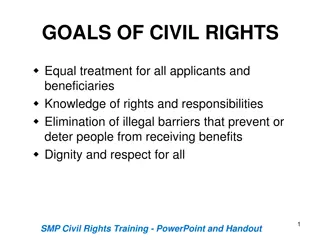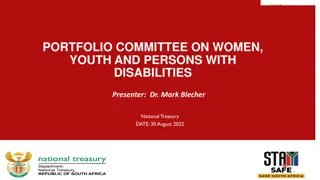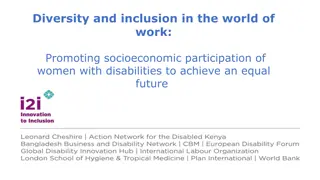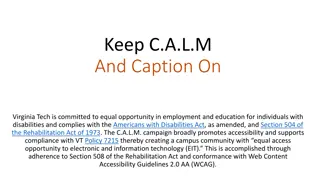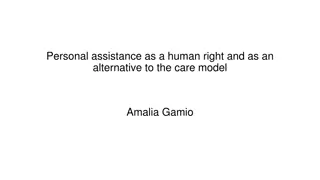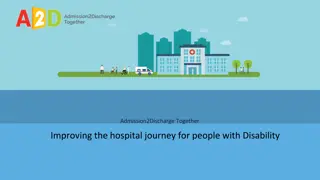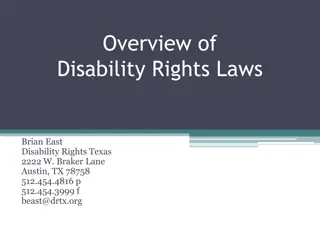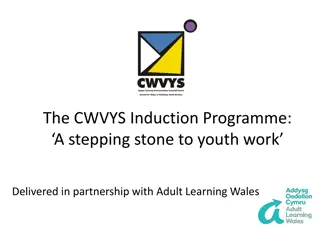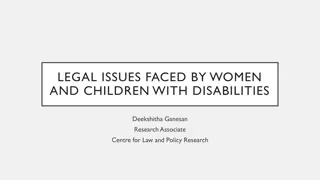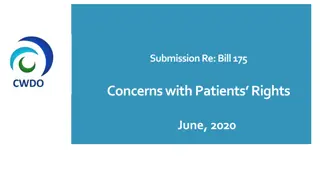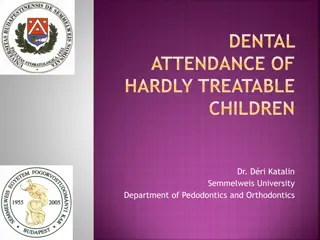Promoting Equal Rights for Youth with Disabilities through the WE DECIDE Programme
The WE DECIDE programme, initiated by UNFPA, aims to empower young persons with disabilities to make decisions regarding their sexual and reproductive health and rights (SRHR). Through advocacy, data collection, and accessibility of services, the programme addresses the specific needs of this community. Objectives include understanding the SRHR and GBV situation, developing implementation tools, and promoting youth participation.
Download Presentation

Please find below an Image/Link to download the presentation.
The content on the website is provided AS IS for your information and personal use only. It may not be sold, licensed, or shared on other websites without obtaining consent from the author.If you encounter any issues during the download, it is possible that the publisher has removed the file from their server.
You are allowed to download the files provided on this website for personal or commercial use, subject to the condition that they are used lawfully. All files are the property of their respective owners.
The content on the website is provided AS IS for your information and personal use only. It may not be sold, licensed, or shared on other websites without obtaining consent from the author.
E N D
Presentation Transcript
WE DECIDE Young persons with disabilities: Equal rights and a life free of violence Leyla Sharafi Gender, Human Rights and Culture Branch Technical Division, UNFPA 28 November 2016 1
ICPD and CRPD ICPD PoA calls on states to address SRH needs of persons with disabilities Articles 23 and 25 of the CRPD also explicitly reference universal access to sexual and reproductive health and rights 2
UNFPAs work on disability Ensuring women, adolescents, young people are empowered to make decisions regarding their sexual and reproductive health and life options UNFPA s existing efforts to address the rights and needs of persons with disabilities including: advocacy and policy dialogue with governments data collection and use and accessibility of SRH information, education and services 3
WE DECIDE programme Launched WE DECIDE programme: Agenda 2030 and no one is left behind Participatory process Promotion of SRHR and address GBV, with focus on youth UNFPA HQ + East and Southern Africa and Eastern Europe + Central Asia regions also focusing SRH and disability 4
Objectives of WE DECIDE programme 1. Better understanding on the situation of SRHR and GBV, as related to adolescents and youth with disabilities Global Study on Youth and Disability Resource package on SRHR and disability statistics 5
Objectives of the WE DECIDE programme 2. Developing Standards and Implementation Tool for implementing service provision to respond to SRHR and GBV for women and young people with disabilities Providing guidance onlegal and human rights framework, common characteristics of quality essential services and service provision for MNCH, FP, STIs/HIV, CSE, Youth friendly services, prevent/address GBV Building on existing resources by UN and non-UN In collaboration with Women Enabled International 6
Objectives of WE DECIDE programme 3. Promote participation of youth with disabilities Supporting the participation of young persons with disabilities in key advocacy and capacity development opportunities In collaboration with International Disability Alliance (IDA) i.e. WHS, ECOSOC, HRC, GA, Bridge CRPD training Strenghtening accessibility of SRHR information for young persons with disabilities, with their full participation In collaboration with Inter-American Institute on Disability and Inclusive Development (iiDi) 7
Objectives of WE DECIDE programme 4. Facilitate networks and communities of practice through knowledge platforms In collaboration with IDA, MSH, iiDi, and other partners 5. Adolescents and youth with disabilities: strengthen advocacy on the prevention of sexual violence and promotion of their sexual and reproductive health and rights 8
Global Study on Youth and Disability: Objectives 1. Provide State-of-the-art analysis on the situation of adolescents and youth with disabilities 2. Provide a detailed assessment of legal, policy and programming developments and specific good practices 3. Provide detailed policy and programming recommendations to assist UNFPA and governments in building a comprehensive programme in this field. 9
Global Study on Youth and Disabilities The two main pillars: Sexual and reproductive health and rights Gender based violence, in particular sexual violence Population group: Adolescents and youth with disabilities from 10-24 years of age Gender Lens: look closely at young women and girls 10
Methodology In-depth desk review and four country visits are the main components of the methodology Primary and secondary data: Primary data: in-person and virtual key informant interviews, in-person focus group discussions, and online surveys Secondary data: in-depth desk review 4 country visits: Ecudador, Mozambique, Morocco and Spain 11
Methodology Case study approach in addition to the four country visits. Purpose: Highlight positive practices that contribute towards the realisation and protection of young persons with disabilities SRHR and the prevention of GBV; Aim to fill potential gaps in information and to promote solutions to the specific barriers faced by young persons with disabilities in regards to SRHR and GBV. Approach: Surveys and virtual key informant interviews with stakeholders related to the identified cases. 12
Timeline for programme Global Study published by June 2017 Standards and Implementation Tool completed by June 2017 Advocacy, youth participation and knowledge platform continues into 2017 and beyond Capacity development with UNFPA COs and government starts mid 2017 and beyond 13
Thank you! 14
